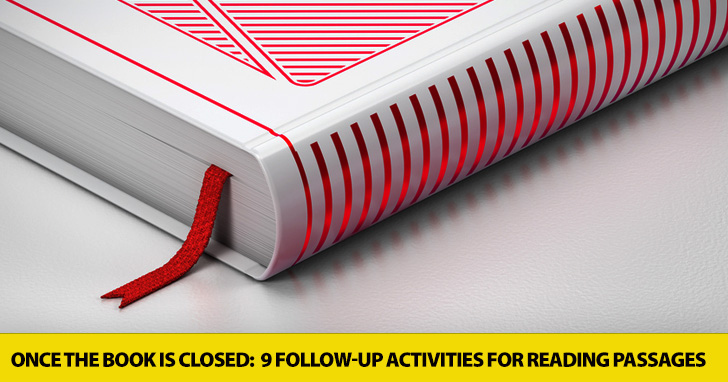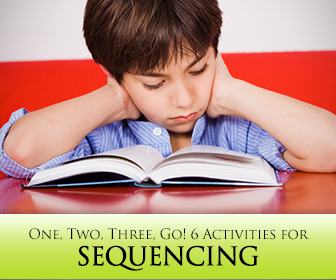Once the Book Is Closed: 9 Follow-up Activities for Reading Passages


One way of helping students understand what they have read is to practice sequencing. Proper sequencing helps students organize information, and it helps them express themselves as well. Sequencing activities are a good addition to any reading program. Here are some ideas you may be able to incorporate into your curriculum.

Encourage your students to think about basic sequencing with this simple activity. Write a typical event on your board such as coming to school, going on a date, buying a television/car, etc. Have students work in groups of two or three to list ten things that must happen before that event can occur and ten things that could happen after that event. Once students have completed their lists, have two groups compare their answers. If you want to give your groups a challenge, have them put each of the ten events in the order in which they should or must happen.
Retelling a story to a partner is good for your students’ speaking skills. You can make double use of a retelling activity by giving students a series of pictures from the story they read. Have students read a story, and then give them six to eight pictures that represent what happened in the story. Make sure these pictures are in random order. Your students can then use the pictures to help them retell the story to a partner. Of course, they will have to put them in the correct order first. Another twist on this activity is to have your students draw the pictures, cut them out, and give them to a partner who must put them in order before using them to retell the story.
Not everyone likes using picture books in their ESL class, but I for one am a fan. The short stories are good for giving students practice with listening comprehension, and the pictures aid in comprehension. The next time you choose to share a picture book with your class, follow up with this activity. Assign each person in your class one page of the book to re-illustrate. The new pictures should communicate the same information which was in the original illustrations. Once everyone in class has completed their pictures, have them mingle and talk to each other until they line their pages up in the correct order from the book. This will challenge their ability to sequence as well as speak to one another. It’s fun, too. If you have too many in your class for one book, break them into two groups and have them create two sets of illustrations. If you have too few students, ask them to combine two or more pictures from the book into one original illustration. Display their pictures around your classroom after you have finished your sequencing activities.
Recipes are a great resource for teaching sequencing. If steps are not carried out in the right order, the result may go from great to ghastly. Take a food that all of your students should know how to make (peanut butter and jelly sandwich, pizza, etc.) and write out the steps to make it. Give groups of two students a copy of the instructions (in random order) and have them cut the directions apart and put them in the correct order. If you like, have your students write the steps to making their own simple recipe in random order and give them to another student to put in the correct order.
Do you know why the old lady swallowed the fly? The answer may be no, but you will want to say yes to this sequencing activity that also reviews animal vocabulary. Start by teaching your students the popular song “There Was an Old Lady Who Swallowed a Fly” and/or reading a book which illustrates the same. Then put students in groups of around three and give each group a set of pictures or have them illustrate their own. Each picture should be one of the animals she swallowed – fly, spider, bird, cat, dog, goat, cow, horse. (You can find the song’s lyrics here.) Ask each group to draw a picture of the woman with enough room to fit all the animals inside. Students should then take turns retelling the story and putting the animals inside their picture of the woman in the correct order. If you like, display the pictures around your classroom so students can admire one another’s art work.
Coherent essays have a particular characteristic. All the paragraphs go in a specific order, and those paragraphs cannot be changed around without losing some of the meaning of the essay. Transitional phrases are the tools writers use to make essays coherent. Some transitional phrases are numeric – first, second, then, finally. Other transitional phrases take an idea in the previous paragraph and bring it into the beginning of the next paragraph. (For example, In addition to causing tooth decay, eating too much candy can contribute to obesity.) If you are teaching academic writing to your ESL students, try this. Have them separate the body paragraphs of an essay they have written or print them on separate pages. Then, have students exchange their paragraphs and see if their partner can correctly sequence the paragraphs using the transitional phrases as clues. If students are able to put their partner’s paragraphs in the right order, the writer has composed a coherent essay. If a person is not able to put the paragraphs in the correct order, the essay is not coherent and needs revision. Encourage your students to strive for coherence in all of their academic writing.
Being able to put events in the correct sequence is important for your students’ understanding and organization of ideas. Whether you teach children who like to sing silly songs or you teach adults preparing for future academic study, everyone in your ESL class will benefit from practicing sequencing.